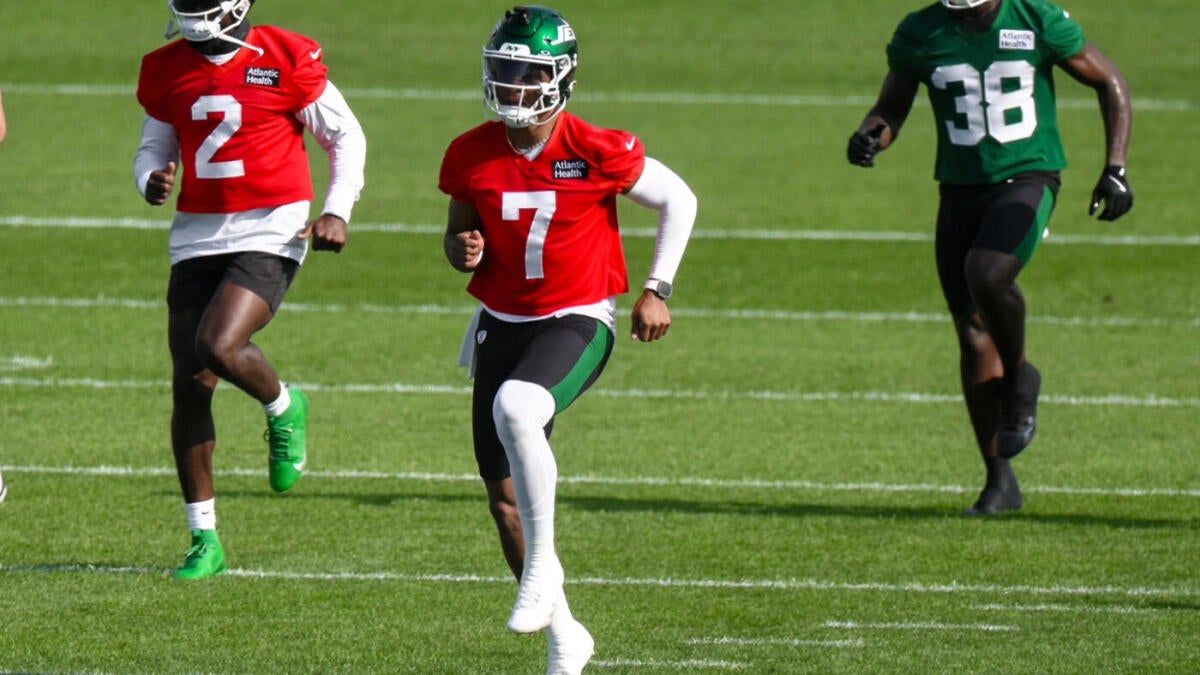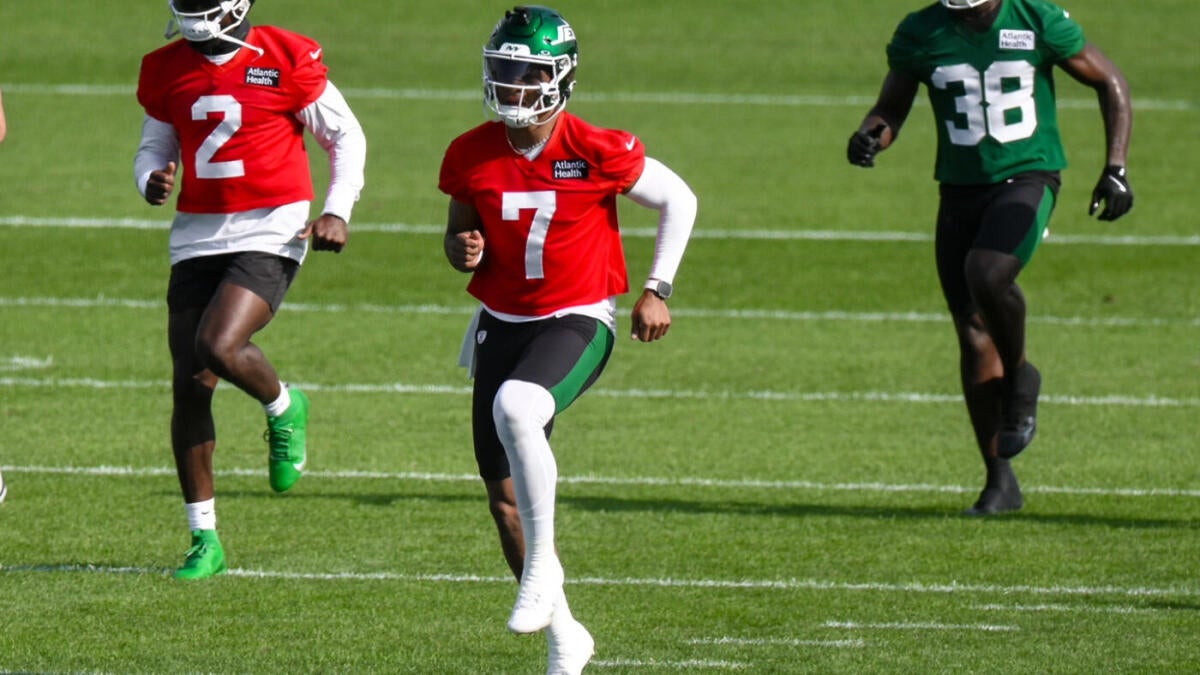Justin Fields’ Toe Injury: A Comprehensive Analysis of the Impact on the New York Jets
Introduction: A Moment of Concern
The New York Jets’ training camp took an unexpected turn when quarterback Justin Fields was carted off the field with a lower leg injury. The sight of the team’s newly named starter being helped off the field sent a wave of concern through the organization and its fanbase. Fields, who represents a significant investment and a beacon of hope for the Jets’ future, had his season potentially hanging in the balance. Fortunately, the initial fears were somewhat alleviated when it was revealed that Fields had suffered a dislocated toe rather than a more severe injury. However, the road to recovery and the potential impact on the Jets’ season remain topics of significant interest and analysis.
The Nature of the Injury: Dislocation vs. Fracture
The initial diagnosis of a dislocated toe on Fields’ right foot was a relief compared to the alternative—a fracture. A fracture would have likely resulted in a longer recovery period and a more complex rehabilitation process. The absence of a fracture suggests a potentially quicker return to the field, but the injury is still significant enough to warrant careful attention.
The injury was specifically identified as a dislocation of a non-big toe. While any toe injury can be problematic for a quarterback, the big toe plays a crucial role in balance and push-off during throws. An injury to one of the smaller toes, while still requiring attention, is generally considered less debilitating. However, any dislocation can cause significant pain and limit mobility, impacting a quarterback’s ability to move comfortably in the pocket and deliver accurate passes.
The Prognosis: Day-to-Day and Beyond
The Jets officially announced that Fields would be considered “day-to-day,” a standard phrase in the NFL that often serves to avoid providing a definitive timeline for recovery. While this suggests the injury isn’t season-ending, it offers little in the way of concrete information. “Day-to-day” could mean Fields misses a few practices, a preseason game, or potentially even the first week of the regular season. The vagueness is intentional, giving the team flexibility and preventing opponents from gaining a competitive advantage.
The optimism expressed by some sources that Fields could be ready for Week 1 should be viewed with cautious optimism. The recovery process for a dislocated toe varies significantly depending on the severity of the dislocation, the individual’s pain tolerance, and the effectiveness of the treatment and rehabilitation. Fields’ dedication to his rehabilitation will be crucial in determining his return timeline.
Training Camp Adjustments: A Temporary Setback
Fields’ absence, however brief, will undoubtedly impact the Jets’ training camp preparations. He will miss valuable practice time, hindering his ability to further integrate into the offensive system and build rapport with his receivers. Even a few days away from the field can disrupt timing and rhythm, crucial elements for a quarterback’s success.
The injury also provides an opportunity for the Jets’ backup quarterbacks to step up and showcase their abilities. While Fields is the clear starter, having a capable backup is essential in the NFL. This situation allows the coaching staff to evaluate the depth at the quarterback position and identify potential weaknesses. The backups’ performance during this time could influence the team’s decisions regarding the quarterback room moving forward.
Long-Term Concerns: Mobility and Performance
While the initial diagnosis is encouraging, the long-term implications of the toe injury should not be dismissed. Even after the initial pain subsides, lingering stiffness, instability, or discomfort could affect Fields’ mobility in the pocket. Quarterbacks rely on their feet to navigate pressure, create throwing lanes, and extend plays. If Fields’ ability to move freely is compromised, it could negatively impact his performance.
The Jets’ medical staff will need to closely monitor Fields’ progress throughout his rehabilitation. They will need to ensure he regains full range of motion, strength, and stability in his toe. A premature return to the field could risk re-injury or the development of compensatory movement patterns that could lead to other problems down the line. The team must prioritize Fields’ long-term health over short-term gains.
Contingency Plans: The Backup Situation
The Jets must have a solid contingency plan in place should Fields’ injury linger or if he experiences any setbacks during the season. The team’s backup quarterback situation will be under increased scrutiny. The coaching staff needs to be confident that the backup quarterback can effectively manage the offense and lead the team to victory if called upon.
This situation underscores the importance of investing in a quality backup quarterback. While it’s ideal to have a healthy and productive starter, injuries are an inevitable part of football. A capable backup can provide stability and prevent a season from unraveling due to a quarterback injury. The Jets’ depth chart at quarterback will be a focal point of analysis and discussion in the coming weeks.
Psychological Impact: Confidence and Pressure
Beyond the physical ramifications, Fields’ injury could also have a psychological impact. The setback might shake his confidence, particularly if he’s still relatively new to the team. He might be hesitant to fully trust his injured toe, leading to tentative movements and a reluctance to take risks.
The pressure on Fields to perform well will also intensify. He’s already facing high expectations as the team’s starting quarterback. The injury adds another layer of complexity, as he’ll need to prove that he can overcome this adversity and still deliver on his potential. The Jets’ coaching staff must be mindful of this psychological aspect and provide Fields with the necessary support to regain his confidence.
A Call for Patience and Prudence
The Jets and their fans need to exercise patience and prudence as Fields recovers from his toe injury. Rushing him back onto the field before he’s fully healed would be a mistake, potentially jeopardizing his long-term health and the team’s season.
The coaching staff should prioritize Fields’ well-being, providing him with the necessary time and support to make a full recovery. They should also have a clear plan in place for managing his workload upon his return, gradually easing him back into game action to minimize the risk of re-injury. The Jets’ approach to this situation will be a testament to their commitment to player health and long-term success.
Conclusion: Navigating Uncertainty with Resilience
Justin Fields’ dislocated toe represents a hurdle, not a catastrophe, for the New York Jets. The absence of a fracture is a positive sign, and the team’s medical staff will undoubtedly work diligently to ensure a full recovery. However, the situation underscores the inherent fragility of football and the importance of having a solid plan B.
The Jets’ success in navigating this uncertainty will depend on a combination of factors: Fields’ dedication to his rehabilitation, the effectiveness of the team’s medical treatment, and the readiness of the backup quarterbacks. While the injury is undoubtedly a setback, it also presents an opportunity for the team to demonstrate its resilience and depth. Ultimately, the Jets’ ability to weather this storm will be a testament to their overall strength and preparedness for the challenges that lie ahead. The season is a marathon, not a sprint, and how the Jets respond to this early adversity will be a telling indicator of their potential for success.












